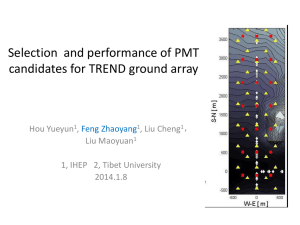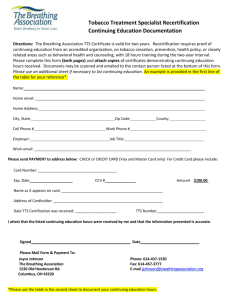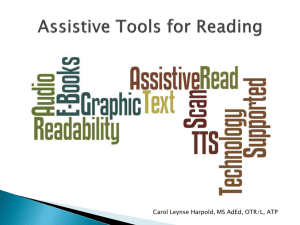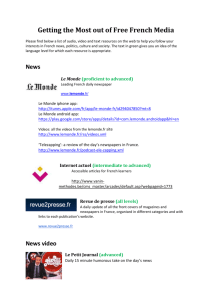EFL Multiple - Choice Vocabulary Test
advertisement
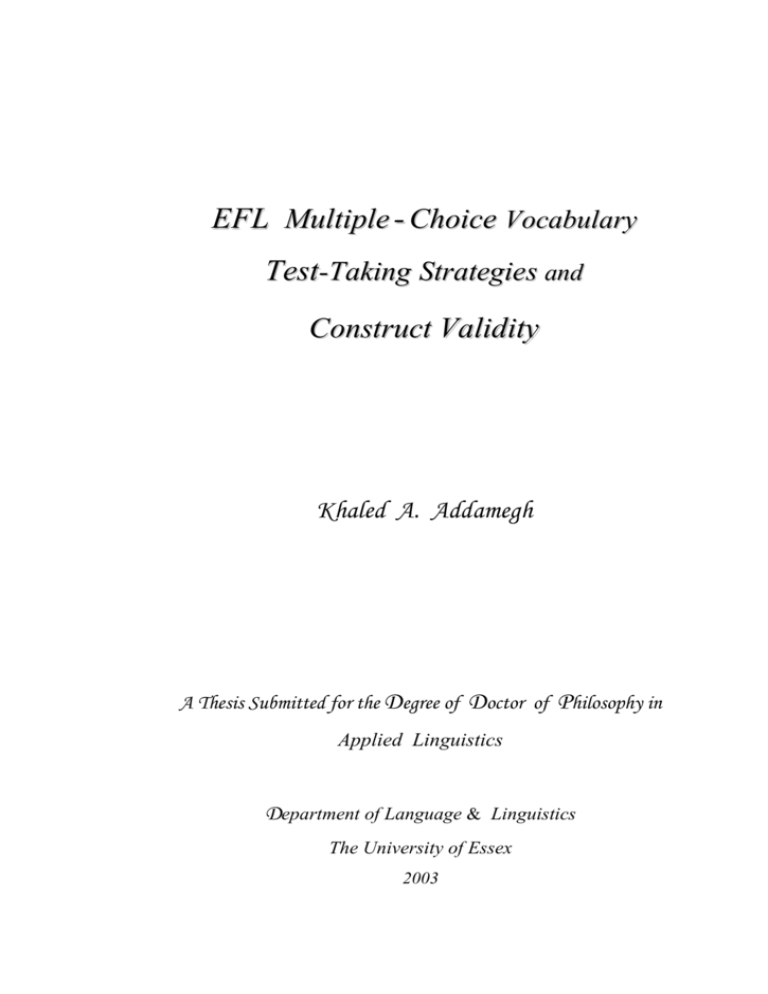
EFL Multiple - Choice Vocabulary Test-Taking Strategies and Construct Validity Khaled A. Addamegh A Thesis Submitted for the Degree of Doctor of Philosophy in Applied Linguistics Department of Language & Linguistics The University of Essex 2003 II ABSTRACT Over the past two and a half decades, numerous studies have detailed the role of learners’ strategies in a variety of L2 domains. However, research on strategies in the process of test-taking, TTS, has been rather scant, though such strategies might influence test scores and consequently test validity. That has motivated this work to explore TTS and their impact on test construct validity. To accomplish its objectives, this research operated within the sequence framework hypothesised by the PPP model, in which a number of variables represent Presage factors, which are likely to influence the test Process embodied in the TTS. These variables, in turn, may affect the test Product, i.e. the test scores obtained. A process-oriented methodology via triangulated verbal data collection was exploited to gain insight into test-takers' mental processes when tackling an EFL multiple-choice vocabulary test. To collect the data required, eight different instruments were utilised with English major university students in two English departments at KSU and UQU in Saudi Arabia. The study contrasted two sources of test item stimuli: one made by professionals at Michigan and Cambridge universities, in USA and UK, and the other locally by EFL instructors at two Saudi Arabian universities. The investigation also explored the influence on the dependent variable of two other independent variables: size of EFL lexicon as determined by Nation’s vocabulary test and general level of EFL proficiency as measured by TOEFL. The analysis revealed sixty-two different TTS of six types: managing the test as a whole, reading the stem, handling the gap, examining the alternatives, selecting a response and strategies after choosing an answer. It also revealed that test-takers with lower L2 proficiency were more active TTS users than the higher proficiency testees. There was a clear difference between the two types of test stimuli, mainly in some of the TTS used to select a response. It was also found that there was a marked effect of the TTS on the test product and, in turn, the test construct. Approximately 40% of test items testing an unknown lexical item were answered correctly based on rational linguistic and nonlinguistic strategies rather than on random promising choice. III DEDICATION To one whose cheerful companionship I have constantly missed .. My late father, may Allah almighty bless him .. IV ACKNOWLEDGEMENTS I first assign glory to Allah for the accomplishment of this work. Though only one of us gets awarded the degree, such work reflects the cooperation of many individuals. In this word of appreciation, I gratefully acknowledge my gratitude to Mr. Phil J. Scholfield for his wise comments and professional guidance throughout his supervision of this work. I am also indebted to King Saud University for sponsorship support. My appreciation is due to many other organisations and people who contributed in this work. I am indebted to Mr. Tony Bouttavong, the International Testing Programme Coordinator at the University of Michigan, USA, for making numerous authentic Michigan EPT and MTELP tests available for us. Thanks are extended to Mrs. Elena Xanthi, the Head of Test Distribution at the Hellenic American Union, Greece, for providing Michigan ECCE tests for this work. Thanks also go to Dr. Ken Sheppard, Association of TOEFL Director for Research, for copyright approval for use of a TOEFL test for this study. Thanks are due to Mr. Michael Brutnell, Publication Co-ordinator of the Local Examination Syndicate at the University of Cambridge, UK, for providing a variety of tests of Cambridge battery. Particular appreciations must go to Dr. Ahmad al-Ghamdi, the Director of the EFL Unit at Umm al-Qura University, for his sincere help in facilitating the data collection phases at the English Department at that university. Thanks are due to all the testees who cooperated in this study at the English Department at Umm al-Qura University and the English & Translation Department at King Saud University in Saudi Arabia. Heartfelt gratitude is particularly due to all the members of my family, my mother M. alMusa, my spouse H. al-Qarawi and my sons Nife, Abdulaziz and Abdulmajid, who have shown considerable concern for the completion of this project. Last, but not least, my gratitude is extended to every individual who contributed directly or indirectly to the successful completion of this project, though his/her name is not acknowledged here. V TABLE OF CONTENTS ABSTRACT .......................................................................................................................... II DEDICATION ...................................................................................................................... III ACKNOWLEDGEMENTS ...................................................................................................... IV TABLE OF CONTENTS .......................................................................................................... V INDEX OF FIGURES ............................................................................................................ XII INDEX OF TABLES ............................................................................................................ XIII LIST OF ABBREVIATIONS .................................................................................................XIV Chapter I: Introduction............................................................................................. 1 I.1 I.1.1 I.1.2 I.1.3 I.2 I.3 I.4 I.5 Motivation for the study ........................................................................................ 1 Test-taking strategies ....................................................................................... 1 Vocabulary ...................................................................................................... 5 Summary of motivation behind the study........................................................ 7 Objectives of the study .......................................................................................... 7 Significance of the study ....................................................................................... 8 Definitions of relevant terms ............................................................................... 11 Overview of the study.......................................................................................... 13 Chapter II: Review of Relevant Literature ................................................................. 15 II.1 The examination system in Saudi Arabia ............................................................ 15 II.1.1 The school assessment system ...................................................................... 15 II.1.2 The university assessment system ................................................................. 18 II.1.3 Conclusion of the review............................................................................... 19 II.2 The achievement test among other assessment types .......................................... 19 II.3 Functions of achievement tests ............................................................................ 21 II.4 Construct validation of tests............................................................................... 22 II.4.1 Function and concept of validity .................................................................. 22 II.4.2 TTS as a source of invalidity ........................................................................ 23 II.4.3 Means of test validation ................................................................................ 25 II.4.4 Construct validity ......................................................................................... 26 II.4.5 Means of construct validation....................................................................... 27 II.4.6 Test-taker’s perspective in validation of tests .............................................. 28 II.4.7 Construct validity of the C-test ..................................................................... 31 II.5 The term ‘strategy’ .............................................................................................. 35 II.5.1 Clarification of the term ‘strategy’ ............................................................... 35 II.5.1.1 Process and strategy ................................................................................ 36 II.5.1.2 Mental or behavioural ............................................................................. 37 II.5.1.3 Consciousness ......................................................................................... 38 II.5.2 Definition of ‘strategy’ for the study ........................................................... 39 II.6 The PPP model as a framework ........................................................................... 41 II.6.1 The concept of the PPP model ..................................................................... 41 II.6.1.1 Biggs’s outline ....................................................................................... 41 II.6.1.2 Wen and Johnson’s Outline ................................................................... 43 II.6.2 The variables of the present study............................................................... 45 II.6.3 A framework for the study .......................................................................... 46 II.7 Human information processing............................................................................ 47 VI II.8 Methods of gathering data on strategies .............................................................. 52 II.8.1 Verbal protocol ............................................................................................... 54 II.8.1.1 Incomplete data ......................................................................................... 54 II.8.1.2 Effect on the process ................................................................................. 57 II.8.1.3 Slower performance................................................................................... 57 II.8.1.4 Probing ...................................................................................................... 58 II.8.1.5 Training ..................................................................................................... 59 II.9 Relevant research ................................................................................................. 60 II.9.1 Nevo’s study ................................................................................................... 60 II.9.1.1 Checklist .................................................................................................... 62 II.9.1.2 Questionnaire............................................................................................. 64 II.9.1.3 Criticism .................................................................................................... 64 II.9.2 Anderson’s study............................................................................................. 66 II.9.2.1 Taxonomy of strategies ............................................................................. 68 II.9.2.2 Criticisms................................................................................................... 70 II.9.3 Storey’s study.................................................................................................. 72 II.9.3.1 Criticism .................................................................................................... 73 II.9.4 Implications for the present study ................................................................... 75 II.10 Summary of Chapter ............................................................................................ 77 Chapter III: A Preliminary Study: ............................................................................. 78 'Types of Vocabulary Test Item Format Utilised in EFL Tests in Saudi Arabia' III.1 Summary .............................................................................................................. 78 III.2 Introduction ......................................................................................................... 78 III.3 Research questions............................................................................................... 81 III.4 Cases and Sampling ............................................................................................. 81 III.5 Procedure ............................................................................................................. 83 III.6 Analysis ............................................................................................................... 84 III. 6.1 Item format classification .............................................................................. 84 III. 6.2 Framework of analysis .................................................................................. 92 III.7 Findings ............................................................................................................... 93 III.8 Result and discussion........................................................................................... 94 III.9 Conclusion ......................................................................................................... 107 III.10 Implications for the Main Study ........................................................................ 108 Chapter IV: The Main Study.................................................................................... 109 IV.1 Research Questions............................................................................................ 109 IV.2 Overview ........................................................................................................... 110 IV.3 Pilot Study ......................................................................................................... 119 IV. 3.1 Objective ...................................................................................................... 112 IV. 3.2 Instrument and materials .............................................................................. 112 IV. 3.3 Pilot subjects ................................................................................................ 112 IV. 3.4 Procedure ..................................................................................................... 113 IV. 3.5 Implications for the main study ................................................................... 113 IV.4 Main Study Subjects .......................................................................................... 114 IV.5 Instruments and Procedures ............................................................................... 117 IV. 5.1 Triangulation................................................................................................ 118 VII IV. 5.2 VP training session ...................................................................................... 120 IV. 5.3 Introspective protocol .................................................................................. 122 IV. 5.4 Immediate retrospective protocol ................................................................ 124 IV. 5.5 Retrospective interviews .............................................................................. 125 IV. 5.6 Checklist ...................................................................................................... 126 IV. 5.7 TOEFL ......................................................................................................... 127 IV. 5.8 Nation’s vocabulary levels test .................................................................... 128 IV. 5.9 Item-difficulty rating instrument.................................................................. 129 IV. 5.10 The study test ............................................................................................... 130 IV.5.10.1 Guiding principles of the study test ......................................................... 130 IV.5.10.2 Choosing PMT and TMT items ............................................................... 131 IV.5.10.3 The level of difficulty of PMT and TMT ................................................ 135 IV.5.10.4 Motivation for taking the test .................................................................. 136 IV.5.10.5 Date of test administration....................................................................... 136 IV.5.10.6 Ordering................................................................................................... 137 IV.5.10.7 Location ................................................................................................... 137 IV.5.10.8 Time allocation ........................................................................................ 140 IV.5.10.9 Presentation ............................................................................................. 141 IV.5.10.10 Procedure ................................................................................................. 142 IV.6 Difficulties ......................................................................................................... 143 IV. 6.1 Listing the test lexical items ........................................................................ 143 IV. 6.2 Immediate interviews................................................................................... 144 IV. 6.3 Audio-recording ........................................................................................... 145 IV.7 Summary of Chapter .......................................................................................... 145 Chapter V: Data Analysis .......................................................................................... 146 V.1 V.2 V.3 V.4 V.4.1 V.4.2 V.5 V.6 V.6.1 V.6.2 V.7 V.7.1 V.7.2 V.8 V.9 Transcription ...................................................................................................... 147 Translation ......................................................................................................... 147 Segmentation ..................................................................................................... 148 Classification ..................................................................................................... 149 Developing the taxonomy scheme ............................................................... 149 Categorisation .............................................................................................. 150 Application ........................................................................................................ 154 Validity of data and analysis.............................................................................. 155 Validity from the triangulated types of evidence ......................................... 155 Validity of the analysis procedures .............................................................. 157 Reliability of segmentation and application ...................................................... 158 Interjudge reliability .................................................................................... 158 Intrajudge reliability .................................................................................... 160 Principles for quantitative analysis .................................................................... 161 Summary of chapter ........................................................................................... 163 VIII Chapter VI: Results and Interpretation of the Tests Used in the Study ................. 165 VI.1 TOEFL ............................................................................................................... 165 VI.2 Nation’s test ....................................................................................................... 168 VI.3 The study test ..................................................................................................... 173 VI.4 Differences between test-takers and test types .................................................. 175 VI.4.1 Difference between test-takers..................................................................... 175 VI.4.1.1 Differences between the test-takers’ universities .......................................... 176 VI.4.1.2 Differences between proficiency groups ....................................................... 176 VI.4.2 Differences between types of test stimuli .................................................... 177 VI.5 Correlations between tests ................................................................................. 177 VI.6 The level of difficulty of the study tests ............................................................ 179 VI.7 Summary of chapter ........................................................................................... 181 Chapter VII: Results and Interpretation: TTS Taxonomy Scheme ....................... 183 VII.1 TTS taxonomy scheme ...................................................................................... 183 a. General test taking strategies ..................................................................................... 184 a.1 Using formulaic utterance for affective value .................................................. 184 a.2 Skipping instructions to save time ................................................................... 185 a.3 Time management ............................................................................................ 186 a.4 Self-encouragement.......................................................................................... 186 a.5 Awareness of TTS ............................................................................................ 187 a.6 Attempting the items in order .......................................................................... 188 a.7 Skipping difficult items and returning later ..................................................... 188 a.8 Revision ........................................................................................................... 188 a.9 Never leaving blank responses ......................................................................... 189 a.10 Estimating the score that will be achieved ....................................................... 189 b. Strategies for stem comprehension ............................................................................ 189 b.11 Skipping unknown vocabulary ......................................................................... 190 b.12 Stating problematic vocabulary........................................................................ 190 b.13 Underlining vocabulary.................................................................................... 191 b.14 Focusing on marks of cohesions ...................................................................... 191 b.15 Rereading ......................................................................................................... 192 b.16 Translation ....................................................................................................... 192 c. Strategies for managing the gap ................................................................................. 193 c.17 Skipping the gap............................................................................................... 193 c.18 Pausing at the gap ............................................................................................ 193 c.19 Elongating the preceding word ........................................................................ 194 c.20 Using a general L1 or L2 filler word ................................................................. 194 c.21 Inserting the alternatives provided ................................................................... 194 c.22 Inferencing the part of speech .......................................................................... 195 c.23 Inferencing meaning in the L1 .......................................................................... 196 c.24 Inferencing the missing word/meaning in the L2 ............................................. 197 d. Strategies for examining the alternatives ................................................................... 198 IX d.25 Scanning alternatives after the stem ................................................................. 198 d.26 Scanning alternatives in order .......................................................................... 198 d.27 Scanning alternatives backwards ..................................................................... 198 d.28 No particular order in scanning the alternatives............................................... 199 d.29 Using L1 cognates to infer the meaning ........................................................... 199 d.30 Using close words in spelling/sound to infer the meaning............................... 200 d.31 Using morphological knowledge to infer the meaning .................................... 201 d.32 Stating problematic alternatives ....................................................................... 201 d.33 Skipping an unknown alternative ..................................................................... 202 d.34 Repetition ......................................................................................................... 202 d.35 Translation ....................................................................................................... 202 e. Strategies for selecting a response ............................................................................. 203 First: Negative line of attack.......................................................................................... 203 e.36 Elimination using pragmatic meaning unlikelihood ........................................ 204 e.37 Elimination using general grammatical rules ................................................... 205 e.38 Elimination using part of speech ...................................................................... 206 e.39 Elimination using lexically dependent grammatical rules ............................... 206 e.40 Eliminating synonymous alternatives .............................................................. 206 e.41 Eliminating unknown alternatives.................................................................... 207 e.42 Eliminating with no stated reason .................................................................... 208 Second: Positive line of attack ....................................................................................... 209 e.43 Selecting using the L1 wording of a collocation............................................... 209 e.44 Selecting using the L2 wording of a collocation............................................... 210 e.45 Selecting using pragmatic meaning likelihood in relation to a word in the stem211 e.46 Selecting using pragmatic meaning likelihood in relation to the stem as a whole or part of it............................................................................................................ 211 e.47 Selecting using a lexically dependent grammatical rule .................................. 212 e.48 Considering the letter of the answer for the preceding item ............................ 213 e.49 Selecting a letter less frequently chosen in the other items .............................. 213 e.50 Selecting a letter more frequently chosen in the other items ........................... 214 e.51 Selecting using English ‘likeness’ ................................................................... 215 e.52 Selecting what ‘sounds nice’ ............................................................................ 215 e.53 Selecting a known alternative .......................................................................... 217 e.54 Selecting an odd alternative in form ................................................................ 218 e.55 Selecting one of two opposite alternatives ....................................................... 218 e.56 Random choice ................................................................................................. 219 e.57 Selecting with no stated reason ........................................................................ 220 f. Strategies after choosing an answer ......................................................................... 220 f.58 Suspending scanning the alternatives when one is picked ............................... 220 f.59 Saying the stem or part of it with the alternative selected................................ 221 f.60 Saying the meaning of the alternative chosen in the L1 ................................... 221 f.61 Changing the answer ........................................................................................ 222 f.62 Marking the item answered correctly ............................................................... 223 X VII.2 Summary of chapter ........................................................................................... 223 Chapter VIII: Results and Interpretation: Quantitative Analysis ......................... 224 VIII.1 Frequencies of TTS: all subjects & all items .................................................... 224 VIII.1.1 General test-taking strategies ....................................................................... 224 VIII.1.2 Strategies for stem comprehension .............................................................. 227 VIII.1.3 Strategies for managing the gap................................................................... 230 VIII.1.4 Strategies for examining the alternatives ..................................................... 232 VIII.1.5 Strategies for selecting a response ............................................................... 235 VIII.1.6 Strategies used after choosing an answer..................................................... 238 VIII.1.7 TTS tokens used by the testees .................................................................... 240 VIII.1.8 Repertoire size of different TTS types ......................................................... 242 VIII.1.9 Correlation between TTS tokens and repertoire .......................................... 243 VIII.2 TOEFL proficiency and TTS........................................................................... 244 VIII.2.1 TOEFL and TTS tokens .............................................................................. 245 VIII.2.2 TOEFL and TTS repertoire......................................................................... 255 VIII.3 Nation’s test and TTS ....................................................................................... 258 VIII.3.1 Nation’s test and TTS tokens ..................................................................... 259 VIII.3.2 Nation’s test and TTS repertoire ................................................................ 265 VIII.4 Difference between PMT and TMT ................................................................. 267 VIII.4.1 Difference between PMT and TMT in TTS tokens ................................... 268 VIII.4.2 Differences between PMT and TMT in the use of different TTS types .... 273 VIII.5 Summary of chapter.......................................................................................... 274 Chapter IX: Results and Interpretation: TTS and the Test Construct Validity ... 276 IX.1 Principles for the selection of cases ................................................................... 276 IX.1.1 Selection of two testees for in-depth qualitative treatment .......................... 278 IX.2 Framework of qualitative analysis ..................................................................... 278 IX.3 Qualitative analysis............................................................................................ 280 IX.3.1 Case 1: S17’s protocol for the first TMT item ............................................. 280 IX.3.2 Case 2: S31’s protocol for the first test item ................................................ 285 IX.3.3 Case 3: S17’s protocol for the middle TMT item......................................... 287 IX.3.4 Case 4: S31’s protocol for the middle TMT test item .................................. 290 IX.3.5 Case 5: S17’s protocol for the last TMT item .............................................. 292 IX.3.6 Case 6: S31’s protocol for the last TMT item .............................................. 294 IX.3.7 Case 7: S17’s protocol for the first PMT item.............................................. 295 IX.3.8 Case 8: S31’s protocol for the first PMT item.............................................. 298 IX.3.9 Case 9: S17’s protocol for the middle PMT item ......................................... 300 IX.3.10 Case 10: S31’s protocol for the middle PMT item ....................................... 302 IX.3.11 Case 11: S17’s protocol for the last PMT item ............................................ 304 IX.3.12 Case 12: S31’s protocol for the last PMT item ............................................ 305 IX.4 Summary analysis for all the item cases ............................................................ 307 IX.4.1 Difficulty in the MCFGV test item format ................................................... 315 IX.5 Conclusion of findings in relation to RQs 6 and 7 ............................................ 318 XI IX.6 Summary of chapter ........................................................................................... 320 Chapter X: Summary, Implications and Suggestions for Further Research ......... 321 X.1 X.2 X.2.1 X.2.2 X.2.3 X.2.4 X.2.5 X.2.6 X.3 X.3.1 X.3.2 X.3.3 X.4 Construct validity of MCFGV tests ................................................................... 321 Theoretical implications .................................................................................... 327 The TTS types and frequencies ................................................................... 328 The TTS Taxonomy .................................................................................... 329 L2 proficiency and TTS ............................................................................... 330 Differences in TTS between the PMT and the TMT ................................... 332 Subconsciously acquired L2 vocabulary ...................................................... 335 The PPP model ............................................................................................ 335 Practical implications......................................................................................... 338 Test construction ......................................................................................... 338 TTS training ................................................................................................ 339 Methodology and other strategies research ................................................. 342 Suggestions for further research ........................................................................ 343 APPENDICES ...................................................................................................... 347 - 392 BIBLIOGRAPHY .......................................................................................................... 393 - 409 XII INDEX OF FIGURES Figure 2.1: Figure 2.2: Figure 2.3: Figure 2.4: Figure 2.5: Figure 3.1: Figure 3.2: Figure 3.3: Figure 3.4: Figure 3.5: Figure 3.6: Figure 3.7: Figure 4.1: Figure 4.2: Figure 4.3: Figure 4.4: Figure 5.1: Figure 5.2: Figure 5.3: Figure 6.1: Relationships among assessment types as adopted from Bachman (1990) ............ 20 The PPP model as suggested by Biggs (1987) for student learning ....................... 42 Factors affecting test achievement as suggested by Wen and Johnson (1997) ...... 44 A model framework for the present study .............................................................. 46 A general model of language processes adapted from Faerch and Kasper (1983) . 51 Distribution of the tests obtained from the four sources ........................................ 82 The three dimensions of a vocabulary test item..................................................... 86 Frequency of the most common EFL vocabulary test formats ............................ 100 Comparison between secondary school and university ....................................... 103 Frequency of the vocabulary test task formats in the four sources ...................... 105 Frequency of the context of the test word in the four sources ............................. 106 Frequency of the types of direct support for answer in the four sources ............. 107 The main stages of data gathering ........................................................................ 111 The triangulation scheme for data collection........................................................ 119 Two versions of the study test to control the influence of order .......................... 137 The laboratory where the subjects took the test & thought aloud ........................ 139 The main steps through which the think-aloud data were analysed..................... 146 ‘Ideal’ steps for attempting an MCFGV meaning test item ................................. 152 Model of the method used be the test takers in tackling MCFGV test items ....... 153 The TOEFL scores for the two proficiency groups (high & low) ........................ 166 Figure 6.2: Figure 6.3: Figure 6.4: Figure 6.5: Figure 8.1: Figure 8.2: Figure 8.3: Figure 8.4: Figure 8.5: Figure 8.6: Figure 8.7: Figure 8.8: Figure 8.9: Figure 8.10: Figure 8.11: Figure 8.12: Figure 8.13: Figure 9.1: Figure 9.2: The means for the two language proficiency groups on TOEFL ......................... 168 Distribution of the subjects on Nation’s Test ....................................................... 169 The means for the two EFL lexical proficiency groups on Nation’s Test ........... 170 Correlation between the performance on PMT and TMT ........................................ 178 Frequency of the general test taking strategies in the test protocols .................... 226 Frequency of the strategies used for stem ............................................................ 228 Frequency of the strategies used to handle the gaps ............................................ 231 Frequency of the strategies used to handle the alternatives ................................. 233 Frequency of the answer selection strategies ....................................................... 237 Frequency of the strategies used after selecting an answer .................................. 239 The correlation between the size of tokens and repertoires ................................ 244 The frequency of TTS tokens for the two TOEFL proficiency groups ................ 246 Repertoires of different TTS types of the two TOEFL proficiency groups ........ 256 The frequency of TTS tokens for the different lexical proficiency groups ......... 259 Repertoires of different TTS of the two lexical proficiency groups .................... 266 Comparison between TTS tokens in the test stimuli............................................ 269 Comparison between the test stimuli in TTS types .............................................. 273 Relationship between e36 and the study test result for 32 testees ........................ 314 Relationship between e36 and the study test result for 28 testees ........................ 315 XIII INDEX OF TABLES Table 2.1: Table 2.2: Table 3.1: Table 3.2: Table 3.3: Table 3.4: Table 3.5: Table 3.6: Table 3.7: Table 3.8: Table 3.9: Table 4.1: Table 5.1: Table 6.1: Table 6.2: Table 6.3: Table 6.4: Table 6.5: Table 6.6: Table 6.7: Table 6.8: Table 6.9: Table 6.10: Table 6.11: Table 8.1: Table 8.2: Table 8.3: Table 8.4: Table 8.5: Table 8.6: Table 8.7: Table 8.8: Table 8.9: Table 8.10: Table 8.11: Table 8.12: Table 8.13: Table 8.14: Table 8.16: Table 8.18: Table 8.19: Table 8.20: Table 8.21: Table 8.22: Table 8.23: Table 8.24: Table 9.1: Table 9.2: Table 9.3: The general education assessment scheme in Saudi Arabia ................................... 16 The grading system in the Saudi universities.......................................................... 19 Classification of the EFL vocabulary meaning test item formats in the data .......... 87 Examples for the test task types provided in Table 3.1 ........................................... 89 Examples of the types of direct support for answer provided in Table 3.1 ............. 90 Examples of the types of context of the test word provided in Table 3.1 ............... 91 Analysis of the data found in secondary school EFL tests ...................................... 96 Analysis of the data found in the university EFL tests............................................ 97 A summary of the data obtained from the university language instructors ............. 97 A statistical summary of the EFL vocabulary test formats in the 4 sources ......... 102 Frequency of each test format category found in the 4 sources ............................ 104 Time allocation: preliminary investigation ............................................................ 140 Interjudge Reliability Coding ................................................................................ 154 Subjects’ scores on TOEFL.................................................................................... 167 The two language proficiency groups on TOEFL .................................................. 168 The two EFL lexical proficiency groups on Nation’s test ...................................... 170 Subjects’ lexical proficiency on Nation’s test ........................................................ 171 Scores achieved on the two versions of the study test............................................ 174 Differences between universities............................................................................ 176 Differences between the high and low groups on the 3 tests used in the study...... 176 Differences related to the PMT and TMT .............................................................. 177 Ccorrelations between the three EFL tests used in the study ................................. 178 Means of the correct answers for each version of the study test ............................ 180 Means of the teachers’ evaluation of difficulty of the study test items .................. 181 Frequency of the general test taking strategies....................................................... 225 Frequency of the strategies used for stem .............................................................. 228 Frequency of the strategies used to handle the gaps ............................................... 230 Frequency of the strategies used to handle the alternatives .................................... 233 Frequency of strategies for selecting an answer ..................................................... 235 Frequency of the strategies used after selecting an answer .................................... 239 The tokens used in the six TTS categories ............................................................. 241 The size of testees’ TTS repertoires over the six categories .................................. 242 Chi-squared test results for TOEFL scores groups on category a TTS .................. 247 Differences between the high and low TOEFL groups in category b TTS ........... 249 Differences between the high and low TOEFL groups in category c TTS ........... 250 Differences between the high and low TOEFL groups in category d TTS ........... 251 Differences between the high and low TOEFL groups in category e TTS ........... 253 Differences between the high and low TOEFL groups in category f TTS ............ 254 Chi-squared test results for the Nation score groups on category a TTS ............... 260 Differences between the high and low Nation groups on category c TTS ............ 262 Differences between the high and low Nation groups on category d TTS ............ 263 Differences between the high and low Nation groups on category e TTS ............ 264 Differences between the high and low Nation groups on category f TTS............. 265 Differences between TTS repertories of Nation groups for each TTS category ... 267 Correlation between PMT and TMT in the TTS tokens ......................................... 270 Correlation between PMT and TMT in TTS types................................................. 274 The selected subjects’ scores on the tests used in the study ................................... 278 Ways in which the test-takers approach the 36 item cases .................................... 309 Summary of the problems occurring in the selected MCFGV test items ............... 318 XIV LIST OF ABBREVIATIONS CPE Certificate of Proficiency in English ECCE Examination for the Certificate of Competency in English EFL English as a Foreign (or Second) Language EPT English Placement Test IELTS International English Language Testing Service KSU King Saud University L1 First Language L2 Second (or Foreign) Language LTM Long Term Memory MCFGV Multiple-Choice Filling-in-the-Gap Vocabulary ML Mental Lexicon MTELP Michigan Test of English Language Proficiency NVLT Nation’s Vocabulary Levels Test PMT Professionally-Made Tests PPP Presage Process Product Model VP Verbal Protocol STM Short Term Memory TMT Teacher-Made Test TOEFL Test of English as a Foreign Language TTS Test-Taking Strategies UCLES University of Cambridge Local Examination Syndicate UQU Umm al-Qura University
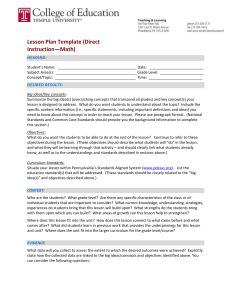
![Lesson Plan Template: Teacher Facilitated Literacy [doc]](http://s3.studylib.net/store/data/006681424_1-f242ece395a51b1c33fbc141f61f3ce4-300x300.png)
![Lesson Plan Template: Inquiry Math, Sci, SS, IntLit [doc]](http://s3.studylib.net/store/data/007094872_1-ccba69dd970115c36506fd8e4c0e34e7-300x300.png)
